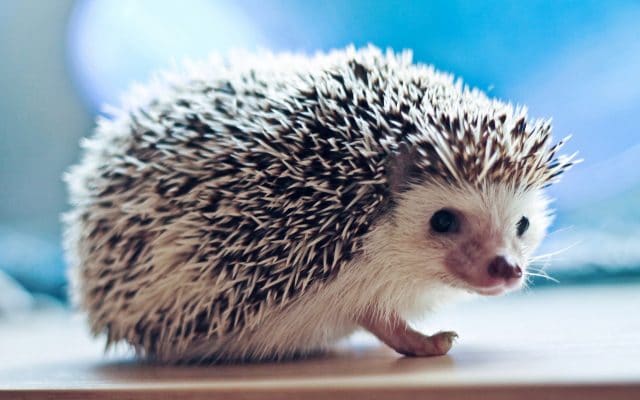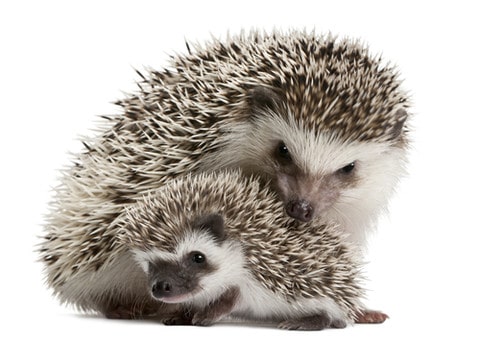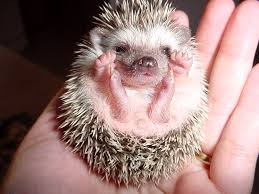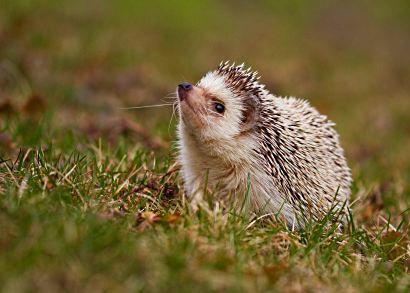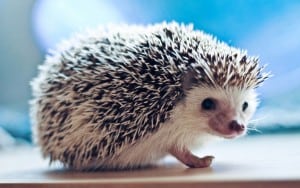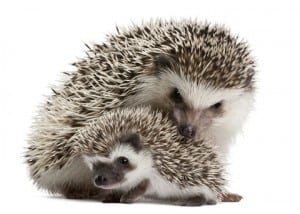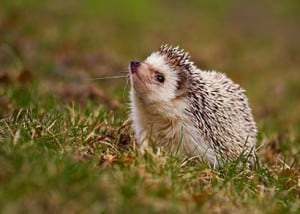Type the name of the breed you're looking for below
[wpdreams_ajaxsearchlite] Don't see the breed your're looking for? Click here and let us know!Hedgehog
| Origin | A hedgehog is any of the spiny mammals of the subfamily Erinaceinae, which is in the order Erinaceomorpha. There are seventeen species of hedgehog in five genera, found through parts of Europe, Asia, Africa and New Zealand (by introduction). There are no hedgehogs native to Australia, and no living species native to the Americas. Hedgehogs share distant ancestry with shrews (family Soricidae), with gymnures possibly being the intermediate link, and have changed little over the last 15 million years. Like many of the first mammals, they have adapted to a nocturnal way of life. Hedgehogs' spiny protection resembles that of the unrelated rodent porcupines and monotreme echidnas. The name hedgehog came into use around the year 1450, derived from the Middle English heyghoge, from heyg, hegge ("hedge"), because it frequents hedgerows, and hoge, hogge ("hog"), from its piglike snout. Other names include urchin, hedgepig and furze-pig. The collective noun for a group of hedgehogs is array or prickle. |
| Natural Habitat | The hedgehog habitat is mainly hedgerows, woodlands and meadows, but they are also commonly found in sub-urban gardens. Within their habitat, they normally have a few sleeping nests. As they are nocturnal creatures, it is not until after dusk that they leave these nests to forage for food.The hedgehog was named because of its peculiar foraging methods. These animals root through hedges and other undergrowth in search of the small creatures that compose the bulk of their diet—insects, worms, centipedes, snails, mice, frogs, and snakes. As a hedgehog picks its way through the hedges it emits piglike grunts—thus, the hedgehog. |
| Wild Species | Hedgehogs are easily recognized by their spines, which are hollow hairs made stiff with keratin. Their spines are not poisonous or barbed and, unlike the quills of a porcupine, cannot easily be removed from the hedgehog. However, spines normally come out when a hedgehog sheds baby spines and replaces them with adult spines. This is called "quilling". When under extreme stress or during sickness, a hedgehog can also lose spines. A defense that all species of hedgehogs possess is the ability to roll into a tight ball, causing all of the spines to point outwards. However, its effectiveness depends on the number of spines, and since some of the desert hedgehogs evolved to carry less weight, they are much more likely to try to run away and sometimes even attack the intruder, trying to ram into the intruder with its spines; rolling up into a spiny ball is used by those species as a last resort. There are a different number of predators for different species: while forest hedgehogs have relatively few predators, primarily birds (especially owls) and ferrets, smaller species like the long-eared hedgehog are preyed on by foxes, wolves and mongooses. Hedgehogs are primarily nocturnal, although, depending on the species, they may be more or less active during the day. The hedgehog sleeps for a large portion of the daytime either under cover of bush, grass, rock or in a hole in the ground. Again, different species can have slightly different habits, but in general hedgehogs dig dens for shelter. All wild hedgehogs can hibernate, although not all do; hibernation depends on temperature, species, and abundance of food. The hedgehog's back is made up of two large muscles, which control the positioning of its quills. There are about 5,000 to 6,500 quills on the average hedgehog, and these are strong on the outer surface, but filled with air pockets on the inside. The hedgehog uses its quills to protect itself from predators, using muscles which draw their quilled skin to cover their full body, and pulling in the parts of their bodies not covered, such as their head, feet, and belly. This form of defense is the hedgehog's most successful, but is usually their last resort. Hedgehogs are fairly vocal and communicate through a combination of grunts, snuffles and/or squeals, depending on species. Self-anointing Hedgehogs occasionally perform a ritual called anointing. When the animal encounters a new scent, it will lick and bite the source, then form a scented froth in its mouth and paste it on its spines with its tongue. The specific purpose of this ritual is unknown, but some experts believe anointing camouflages the hedgehog with the new scent of the area and provides a possible poison or source of infection to predators poked by their spines. Anointing is sometimes also called anting because of a similar behavior in birds. Similar to opossums, mice and moles, hedgehogs have some natural immunity against snake venom due to the protein erinacin in the animal's muscular system, although it is only available in small amounts, and so a viper bite, for example, may kill the hedgehog anyway. In addition, hedgehogs are one of four known mammalian species which possess mutations in the nicotinic acetylcholine receptor that protects against another snake venom, α-neurotoxin. Pigs, honey badgers, mongooses, and hedgehogs all have modifications to the receptor pocket which prevents the snake venom α-neurotoxin from binding. These represent four separate, independent mutations. |
| History with Humans | The most common species of domesticated hedgehog is the African pygmy hedgehog, a hybrid of the white-bellied or four-toed hedgehog (Atelerix albiventris) and the Algerian hedgehog (A. algirus). It is smaller than the European hedgehog, and thus is sometimes called African pygmy hedgehog. Other species kept as pets are the Egyptian long-eared hedgehog (Hemiechinus auritus auritus) and the Indian long-eared hedgehog (Hemiechinus collaris). Hedgehog domestication became popular in the early 1980s. They still have much of their wild behavior, including a fear of predators—especially humans—but buying from a responsible breeder and proper handling will do a lot to ensure a friendly relationship. Since domestication began, several new colours of hedgehogs have been created or become common, including albino and pinto hedgehogs. Domesticated species prefer a warm climate (above 22 °C, 72 °F) and do not naturally hibernate. Attempts to hibernate due to lowered body temperatures can be fatal, but are easily reversed if caught within a few days. In the wild they eat a diet of mainly insects, but pet owners generally prefer a diet composed primarily of high protein low fat high quality cat food, with regular treats such as mealworms, fruits, vegetables, and cooked unseasoned meats. |
| As Pets | The most common pet species of hedgehog are hybrids of the white-bellied hedgehog or four-toed hedgehog (Atelerix albiventris) and the North African hedgehog (A. algirus). It is smaller than the European hedgehog, and thus is sometimes called the African pygmy hedgehog. Other species kept as pets are the long-eared hedgehog (Hemiechinus auritus) and the Indian long-eared hedgehog (H. collaris). It is illegal to own a hedgehog as a pet in some US states and some Canadian municipalities, and breeding licenses are required. No such restrictions exist in most European countries with the exception of Scandinavia. In the UK wild hedgehogs are considered endangered and it is illegal to keep one as a pet. In Italy it is illegal to keep wild hedgehogs as pets. |
| Colour Variations | White-Bellied Standard colours: Although the term "White-Bellied” is commonly used to refer to a species of hedgehog, the IHA also recognizes it as a separate colour category from that of the Algerian colours. A hedgehog exhibiting the colour traits of a White-Bellied may or may not exhibit the physical traits. (Smaller body, shorter nose and smaller ears than that of the Algerian) Since the two species have been interbred to produce the domestic hedgehog, the only true trait of the White-Bellied species left is the colour as this does not mix with the colours of the Algerian species. White-Bellied coloured hedgehogs can be easily distinguished by looking at the "eye" or "cheek" patches. If the hedgehog has no cheek patches, or if they are very small, consisting of black hairs, then the hedgehog in question is in the White-Bellied colour range. If the mask is strong and golden-brown or orange, then the hedgehog is in the Algerian range. This is a far more accurate means of identification than the older method of looking for white quills, rather than the "cream" or off-white coloured quills of the Algerian-coloured hedgehog. White-Bellied Standard: This is not to be confused with the Standard show class of the same name, but to identify the colour pattern wherein hedgehogs have almost all banded quill coats with only a small number of unbanded quills. There are 26 known Standard colours—13 White-Bellied and 13 Algerian—with 2 more potential colours—1 White-Bellied and 1 Algerian—both related to black. (Algerian Black and White-Bellied Salt & Pepper) SALT & PEPPER: The quills are white, banded by black. Almost all of the quills are banded. The skin on the shoulder is jet-black. The nose is black. The eyes are black. The mask is small but black. Black mottling of the underbelly is extensive. DARK GREY: The quills are white, banded by black with very narrow rusty-brown outer edges. Almost all of the quills are banded. The skin on the shoulders is dark grey, almost black The nose is black. The eyes are black. The mask is small but black. Black mottling of the underbelly is extensive. GREY: The quills are white, banded by black with rusty-brown outer edges. Almost all of the quills are banded. The skin over the shoulders is grey. The nose is black. The eyes are black The mask is small but black. There is some mottling of the underbelly. CHOCOLATE: The quills are white, banded by dark brown. Almost all of the quills are banded. The skin on the shoulder is light grey. The nose is dark liver, almost black. The eyes are black The face is masked by very light brown. There may be pale mottling of the underbelly. BROWN: The quills are white, banded by light oak-brown. Almost all of the quills are banded. The skin on the shoulders is pink with a small amount of grey pigmentation. The nose is chocolate-brown. The eyes are black and have a light blue ring around the outer edges (the sclera). There is a pale brown mask. There is no mottling of the underbelly. CINNAMON The quills are white, banded by light cinnamon brown. Almost all of the quills are banded. The skin on the shoulders is pink. The nose is liver. The eyes are black. The face is not masked. The underbelly is white with no mottling. DARK CINNICOT: The quills are white, banded 75% by cinnamon brown and 25% by pale orange-beige. Almost all of the quills are banded. The skin over the shoulders is pink. The nose is liver with a pink outer rim. The eyes are black The face is not masked. The underbelly is white with no mottling. BLACK-EYED CINNICOT: The quills are white, with 50% banded by cinnamon and the remainder by pale orange-beige. Almost all of the quills are banded. The skin over the shoulders is pink. The nose is pink and liver mottled. The eyes are black. The face is not masked. The underbelly is white with no mottling. RUBY-EYED CINNICOT: The quills are white, with 50% banded by cinnamon and the remainder by pale orange-beige. Almost all of the quills are banded. The skin over the shoulders is pink. The nose is pink and liver mottled. The eyes are dark ruby-red. The face is not masked. The underbelly is white with no mottling. CHAMPAGNE: The quills are white, with 75% banded by pale orange-taupe, with the remainder banded by cinnamon. Almost all of the quills are banded. The skin over the shoulders is pink. The nose is pink with a liver outer rim. The eyes are red. The face is not masked. The underbelly is white with no mottling. APRICOT: The quills are white, banded by pale orange. Almost all of the quills are banded. The skin over the shoulders is pink. The eyes are red. The nose is pink. The face is not masked. The underbelly is white. |
| Care | When you bring you new hedgehog home, place him in his new cage and let him have absolute privacy for at least a day. You may pick him up and hold him once or twice for a few minutes the first day, but remember, it will probably be more like a week before he begins to feel at home. Baby hedgehogs need quite a bit of sleep the first month after they come home with you, so don't be too concerned if he sleeps a lot at first. |
| Bath Requirements | Grooming: Although hedgehogs are fairly clean animals and rarely need grooming, hedgehog owners are generally advised to maintain their hedgehog's cleanliness through periodic baths. Most owners find it easiest to bathe hedgehogs in a kitchen sink filled with a few inches of water. The ideal frequency of baths depends on a hedgehog's breed and individual tendencies, so owners should consult a trusted breeder or hedgehog expert before developing a bathing schedule. In addition, a hedgehog's nails need to be trimmed. Trimming hedgehog nails can be done carefully with baby nail clippers at home, or by some veterinarian offices trained in hedgehog care. |
| Housing | In the wild, a hedgehog will cover many miles each night. Keeping this in mind, a hedgehog requires as much room as possible. Without room, a hedgehog will show signs of depression, such as excessive sleeping, refusal to eat, repetitious behaviour, and self-mutilation. Due to their small size obesity is a very dangerous problem and hedgehogs require a fair amount of exercise to avoid liver problems due to excess weight. Pet cages with a floor area measuring 5 square feet (0.46 m2) or more are suitable for pet hedgehogs. Cages with wired floors are dangerous for hedgehogs because they can easily slip and get a limb caught in the wire. Multi-level ferret or rabbit cages can allow a hedgehog more room to explore without taking up extra floorspace, but when using multiple levels, keep in mind that a hedgehog has poor eyesight, can climb easily, but has difficulty descending and often does not seem to understand heights, so it is highly recommended that ramps and levels be completely enclosed to prevent a fall. Some people use large glass aquariums but these can be heavy and awkward to clean and offer little ventilation. Very large steralite storage bins are a common DIY cage and are inexpensive, easy to clean, and versatile, but they must be of a considerable size and must be ventilated properly. Another popular do it yourself cage is a "C & C" cage made out of cubes and coroplast, also called corrugated plastic. C & C cages can be made larger than store-bought cages and can be built one on top of the other to house multiple hedgehogs vertically without the need for shelving. A wheel is necessary to provide hedgehogs with exercise. Some hedgehogs refuse to run in a wheel, so other forms of exercise must be substituted. When choosing a wheel, it must have a solid floor. If an open-wire wheel is used, the hedgehog will continually fall between the bars and possibly break a leg. Wheels with crossbars can also cause facial injuries as hedgehogs have been known to look sideways out of the wheel while running. For this reason "bucket" type wheels are preferred by many hedgehog owners, and they are available from many breeders. DIY articles are also readily available for those wishing to attempt making one themselves. Vellux blanket material is preferred for bedding by many because it does not fray and is easy to clean up. This is a plushy velour-like material often used for hotel blankets. Strings from frayed edges on blankets have been known to wrap around hedgehog's legs, causing amputation, so any frayable fabric that is to be near the hedgehog must be checked thoroughly to avoid problems. Fleece blankets can also be used, but the edges should be sewn so that there are no stray threads in which a hedgehog could catch itself. Recycled newspaper beddings are also popular. Cedar and pine bedding have wood oils that are dangerous to hedgehogs and can cause lung issues and even sores. However, aspen shavings contain no such oils and are safe for use in hedgehog enclosures. Some beddings can be dangerous due to dust content or propensity to clump up on the hedgehog, others may even get stuck in the hedgehog's genitals. Careful research is necessary before using any unusual bedding materials. The enclosure should be kept above 70 °F (21 °C) or the hedgehog will attempt to hibernate. Habitat: Hedgehogs need plenty of space to explore. Cages for hedgehogs can be varied and offer many options, which can include rabbit/other animal cages, or homemade cages. Cages should be big enough for hedgehogs to run around in and have enough space for the equipment needed for the animal. The floor of the cage should be smooth, not wire, to make sure that the feet of the hedgehog do not get hurt. The top of the cage should be open to create enough air flow. In addition, the cage requires a hideaway for the hedgehog, a wheel, food/water bowl, a heat lamp, an optional thermometer, and toys. On the bottom of the cage there needs to be bedding in order to keep the hedgehog warm and offer them a soft material on their feet. Many materials can be used as bedding including, wood chips, newspaper, and fleece. Only soft material should be used because wire/mesh/rough materials could harm the hog. Sawdust based litter should be avoided because the dust in it can cause lung problems in the animal. Hideaways, which include beds for sleeping, should be always available to hedgehogs. These allow the hedgehogs to relax and sleep in an isolated area to feel safe. Options for hideaways and beds include pet igloos, sleeping pouches, tunnel, half log, and anything that offers them a place to feel safe and comfortable by themselves. Wheels are also a necessity for the cage because it offers the hedgehog daily exercise. The wheel should also be solid and not wire because wire wheels hurt the paws of hedgehogs. Heat lamps are also a necessity for hedgehogs. Hedgehogs need to be in an environment of 75-80 degrees constantly. Heat lamps should be positioned on top of the cage so that it could heat up the entire area. Thermometers are a good option to add to the hedgehog cage because it shows the temperature of the cage at all times, allowing for maximum care for the animal. In addition, toys are great options for hedgehogs because it offers fun time and relaxation. |
| Health | Reproduction and lifespan: Depending on the species, the gestation period is 35–58 days. The average litter is 3–4 newborns for larger species and 5–6 for smaller ones. As with many animals, it is not unusual for an adult male hedgehog to kill newborn males. Hedgehogs have a relatively long lifespan for their size. Larger species of hedgehogs live 4–7 years in the wild (some have been recorded up to 16 years), and smaller species live 2–4 years (4–7 in captivity), compared to a mouse at 2 years and a large rat at 3–5 years. Lack of predators and controlled diet contribute to a longer lifespan in captivity (8–10 years depending on size). Hedgehogs are born blind with a protective membrane covering their quills, which dries and shrinks over the next several hours. The infants are born with quills beneath the skin, like pimples, and pass the skin after they have been cleaned. Diseases: Hedgehogs are prone to many diseases, including cancer, which spreads quickly in hedgehogs, and wobbly hedgehog syndrome, a neurological syndrome. Some symptoms of wobbly hedgehog syndrome resemble those of multiple sclerosis (MS) in humans, therefore the condition the animal experiences can be compared with what MS patients experience. A possible cause of WHS is a genetic flaw allowing a virus to attack the hedgehog's nervous system. The nose can display a variety of symptoms of a troubled hedgehog, especially respiratory illnesses such as pneumonia. In many cases, the form of pneumonia that affects hedgehogs is bacterial in nature. If acted upon quickly, antibiotics can have a very positive effect. Signs to watch for include bubbles, excessive dripping, or constant sneezing. Hedgehogs usually react to stress with temporary digestive disorders that include vomiting and green feces |
| Diet | Although traditionally classified in the now abandoned order Insectivora, hedgehogs are not exclusively insectivores but are omnivorous. They feed on insects, snails, frogs and toads, snakes, bird eggs, carrion, mushrooms, grass roots, berries, melons and watermelons. Berries constitute a major part of an Afghan hedgehog's diet in early spring after hibernation. In the wild, a hedgehog is opportunistic and will eat many things, but the majority of the diet comprises insects. As insectivores, hedgehogs need a diet that is high in protein and low in fat. They also require chitin, which comes from the exoskeleton of insects; fiber in the diet may substitute for the chitin component. There are prepared foods specifically for pet hedgehogs and insectivores, including foods made from insect components. Also available are alimentary powders to sprinkle on other food which provide chitin and other nutrients. Hedgehog caretakers should read labels on packaged food to ensure a basis of protein, rather than a basis of carbohydrate. A dry cat-food mix can serve as a daily base food. Most caretakers mix several high-quality (mostly meat and little meat byproduct), low-fat cat foods to ensure nutrition and aim for a protein content of higher than 30% and a fat content of no greater than 12%. Approximately 10 to 12% fiber is also suggested. Normal cat food is high in fat and iron, so indoor or light formulations are generally more appropriate. Most breeders also suggest foods derived primarily from chicken. There are hedgehog foods available at many pet shops, but most do not seem to be good quality formulations and will not provide the quality and level of nutritional contents necessary for a healthy hedgehog. One should always check the ingredients list for good quality ingredients and nutritional information for high protein and low fat content. Pet hedgehogs may eat such table foods as cooked, lean chicken, turkey, beef or pork (in moderation due to fat content). Hedgehogs will often eat small amounts of vegetable and can be given small amounts of fruit as treats. Baby food is a common way to feed treats. Hedgehogs are lactose-intolerant and will have stomach problems after consuming most dairy products, though occasional plain lowfat yogurt (yogurt contains bacteria that naturally process lactose) or cottage cheese seem to be well tolerated. Sugar intake should be restricted to fruits, and treats with added sugar avoided. Fresh, canned, or freeze-dried mealworms, waxworms, and crickets are appropriate as limited treats though in moderation as many feed insects are high in fat. Many pet stores carry these feed insects. Hedgehog caretakers should avoid bait-shop or wild caught insects, which may be contaminated with insecticides. Hedgehogs can easily become obese. If a pet hedgehog appears to be gaining too much weight, it is important that the hedgehog’s caretaker cut back on high fat foods and increase exercise. Hedgehogs vary in size so there is no "goal weight" for a hedgehog, but if they can no longer roll completely into a ball it is a pretty clear sign of obesity. Many people believe that there is a relation between a high-fat diet and fatty-liver disease in hedgehogs. Due to their mouth shape hedgehogs should not be fed any nuts. Nut butters are acceptable, but are very high in fat so they should probably be avoided. Hedgehogs should never be fed avocados, onions, grapes or raisins, chocolate, any raw meat or egg yolks, or any canned or processed food. |
| Dentistry | Hedgehogs have 36-44 teeth in a long, pointy snout. The first pair of incisors is slightly larger than the rest, but they are certainly not as dramatically different in size from their other teeth as a rodent’s front teeth. Hedgehog incisors do not continuously grow, as do rodent incisors, and so they do not have an innate need to chew or gnaw on things to wear down their teeth. The baby teeth are shed early and replaced by rooted adult teeth. Poor diet can cause tooth decay and gum disease. |
| Infectious Diseases | External parasites of the hedgehog Hedgehog fleas: Hedgehogs are renowned for having fleas. However, the fleas found on hedgehogs are actually hedgehog fleas (scientific name: Archaeopsylla erinacei) which are host specific, meaning they will not survive for long on any other species, be it pets or people. Occasionally hedgehogs can become infested with fleas but usually they will only have a few resident fleas which will cause them no harm. Hedgehog ticks: Ticks are another common external parasite on hedgehogs. Usually an individual will have a couple of ticks on it though occasionally there are hedgehogs with heavier burdens. Ticks are commonly attached to the underside, behind the ears or the flanks of hedgehogs but they can occur elsewhere as well. Ticks are in general harmless to hedgehogs. However, a high parasite load can be indicative of sickness. Ringworm: Ringworm can also be quite prevalent in hedgehogs, with around a quarter of the national population thought to be affected. Most hedgehogs show no visible symptoms and even those with severe infections can still show little sign of skin infection and can feed normally. Dry, crusty ears are one of the most common symptoms of a ringworm infection. Internal parasites: Hedgehogs can be host to a number of different parasitic worms, with lungworm being especially prevalent in European hedgehogs. Lungworm infection can result in a dry rattling cough and can prove fatal if left untreated. A mild worm burden is to be expected in most hedgehogs but this should cause few problems to them. |
| Mental Health | Your relationship with your Hedgehog should be co dependable. As a pet owner, you should feel loved and needed as you care for your charming companion. In return, your pet should thrive off of the care and attention you give to it. While you form a bond with your Hedgehog, it will learn to trust you and form a unique relationship with it's owner. Frequent, gentle handling is a great way to maintain this relationship and keep your Hedgehog tame and social. Hand-feeding your pet, with treats like live mealworms, is a good way to bond and gain trust. While these animals are friendly with humans, they usually do not get along well with other Hedgehog's and housing them together (no matter the gender) is not recommended unless you're trying to breed. Physical exercise is an important factor in Hedgehogs life, helping to keep them healthy and happy. In the wild, these animals are used to exploring throughout the night and foraging for food. In captivity, these activities can be replicated by providing an extra area, like a small (empty) children's pool, for them to roam. If you're going to let your Hedgehog wander outside, make sure to keep a close eye on it because they are avid explorers and can scurry away surprisingly fast. An exercise wheel is a great addition to this pet's cage to provide nighttime entertainment and help prevent obesity. Exercise balls are less recommended because these animals tend to get bored or feel stressed when confined for long periods of time. Mental stimulation is an important factor of caring for your Hedgehog and should be part of their daily routine. Toys are a great way to supplement the environment of your Hedgehog and provide enrichment for their active senses. Pieces that can be explored, like tunnels, tubes, and hideaways, seem to be most entertaining for them. Small, round toys that they can push around are also engaging and fun! Try hiding some treats to promote your Hedgehog's natural foraging instincts. |

